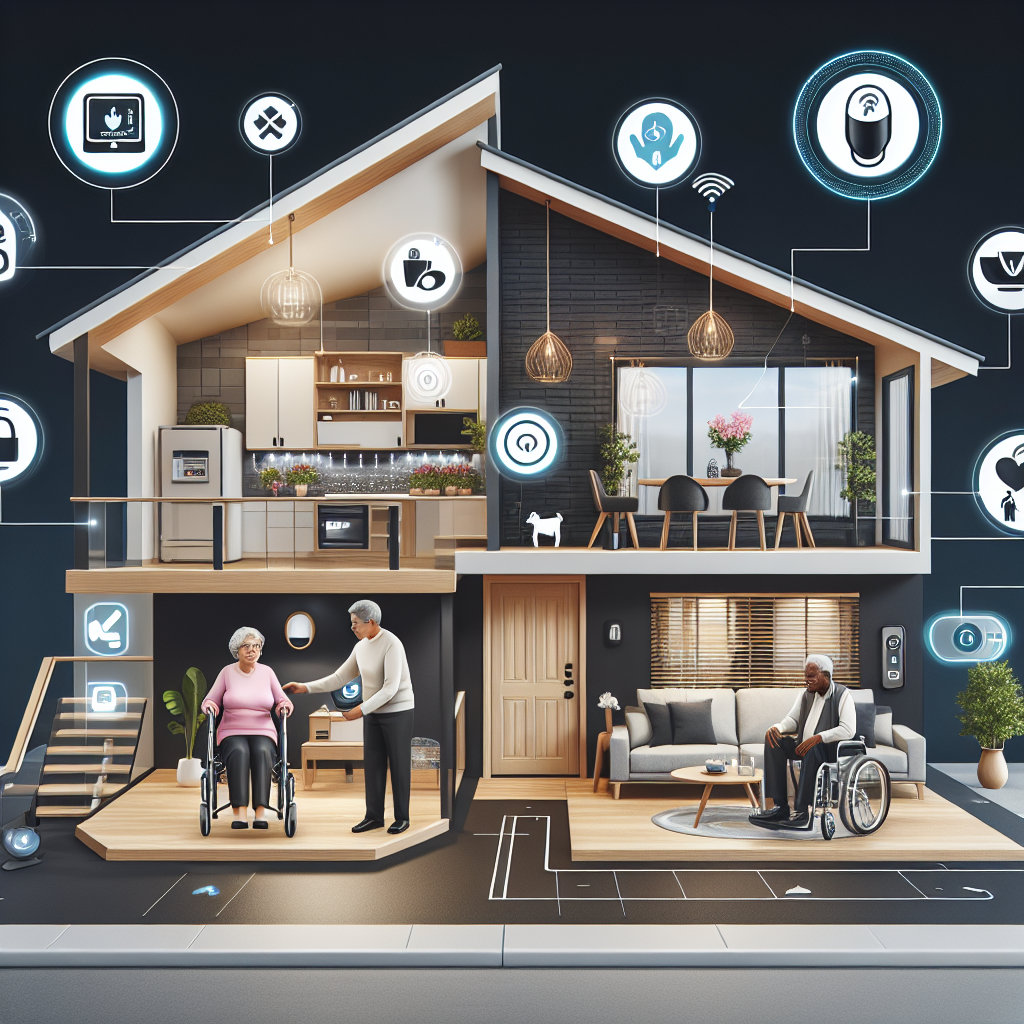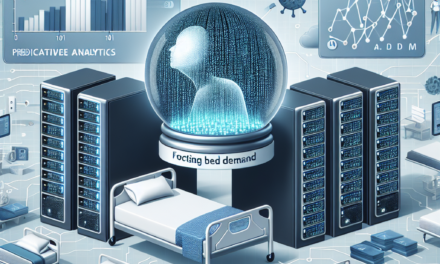Essential Smart Home Innovations for Senior Safety and Independence

As the global population ages, ensuring the safety and independence of seniors has become a pressing concern. Smart home technology offers innovative solutions that can significantly enhance the quality of life for older adults. These technologies not only provide safety and security but also promote independence, allowing seniors to live comfortably in their own homes for longer. This article explores essential smart home innovations that are transforming the lives of seniors, providing detailed insights into their functionalities, benefits, and real-world applications.
1. Smart Home Security Systems
Security is a primary concern for seniors living independently. Smart home security systems offer comprehensive solutions that ensure the safety of older adults while providing peace of mind to their families. These systems are designed to be user-friendly and can be customized to meet the specific needs of seniors.
1.1 Advanced Surveillance Cameras
Modern surveillance cameras are equipped with high-definition video capabilities, night vision, and motion detection. These features allow for real-time monitoring of the home environment, ensuring that any unusual activity is promptly detected and addressed. For seniors, this means enhanced security without the need for constant supervision.
Many smart cameras also offer two-way audio, enabling seniors to communicate with visitors or family members remotely. This feature is particularly useful for those with mobility issues, as it allows them to interact without having to physically move to the door.
1.2 Smart Doorbells
Smart doorbells are another essential component of a senior-friendly security system. These devices come with built-in cameras and microphones, allowing seniors to see and speak with visitors before opening the door. This not only enhances security but also provides a sense of control and independence.
Some smart doorbells are integrated with mobile apps, enabling family members to monitor who is at the door and receive alerts if there is any suspicious activity. This feature is particularly beneficial for seniors living alone, as it provides an additional layer of security.
1.3 Automated Locks
Automated locks eliminate the need for physical keys, which can be easily lost or forgotten. These locks can be controlled via smartphones or voice commands, making them ideal for seniors with limited mobility or cognitive impairments. Automated locks also allow family members or caregivers to grant access remotely, ensuring that help is always available when needed.
Moreover, automated locks can be programmed to lock or unlock at specific times, providing an added level of security and convenience. This feature is particularly useful for seniors who may forget to lock their doors, reducing the risk of unauthorized entry.
1.4 Emergency Response Systems
Emergency response systems are crucial for seniors living independently. These systems are designed to provide immediate assistance in case of an emergency, such as a fall or medical issue. Many smart home security systems now include integrated emergency response features, such as panic buttons or wearable devices that can alert emergency services with a single press.
These systems often come with GPS tracking, allowing responders to locate the senior quickly and accurately. This feature is particularly beneficial for seniors with dementia or other cognitive impairments, as it ensures that help can be dispatched promptly in case of an emergency.
1.5 Case Study: Enhancing Security for Seniors
A case study conducted by a leading smart home technology company demonstrated the effectiveness of smart security systems in enhancing the safety of seniors. The study involved a group of seniors living independently, who were provided with a comprehensive smart security system, including surveillance cameras, smart doorbells, and automated locks.
The results showed a significant reduction in security-related incidents, with participants reporting increased feelings of safety and independence. Family members also expressed greater peace of mind, knowing that their loved ones were protected by advanced security technology.
2. Smart Health Monitoring Devices
Health monitoring is a critical aspect of senior care, and smart home technology offers innovative solutions that enable seniors to manage their health effectively. These devices provide real-time data and insights, allowing seniors to monitor their health conditions and make informed decisions about their care.
2.1 Wearable Health Trackers
Wearable health trackers are designed to monitor various health metrics, such as heart rate, blood pressure, and physical activity levels. These devices provide seniors with valuable insights into their health, enabling them to track changes and identify potential issues early.
Many wearable trackers are equipped with features such as fall detection and emergency alerts, providing an added layer of safety for seniors. These devices can automatically notify family members or emergency services in case of a fall or other health emergency, ensuring that help is available when needed.
2.2 Smart Medication Dispensers
Medication management is a common challenge for seniors, particularly those with multiple prescriptions. Smart medication dispensers offer a solution by automating the process of medication administration. These devices can be programmed to dispense the correct dosage at the right time, reducing the risk of missed or incorrect doses.
Smart dispensers often come with reminders and alerts, ensuring that seniors take their medication as prescribed. Some devices also offer remote monitoring capabilities, allowing family members or caregivers to track medication adherence and intervene if necessary.
2.3 Remote Health Monitoring Systems
Remote health monitoring systems enable seniors to track their health conditions from the comfort of their homes. These systems use a combination of sensors and devices to collect data on various health metrics, such as blood glucose levels, oxygen saturation, and weight.
The data is transmitted to healthcare providers, who can monitor the senior’s health remotely and provide timely interventions if needed. This approach not only enhances the quality of care but also reduces the need for frequent hospital visits, promoting independence and convenience for seniors.
2.4 Smart Sleep Monitors
Quality sleep is essential for overall health and well-being, particularly for seniors. Smart sleep monitors provide insights into sleep patterns and quality, helping seniors identify issues such as sleep apnea or insomnia.
These devices use sensors to track movements, heart rate, and breathing patterns during sleep. The data is analyzed to provide personalized recommendations for improving sleep quality, such as adjusting bedtime routines or making changes to the sleep environment.
2.5 Case Study: Improving Health Outcomes with Smart Devices
A study conducted by a healthcare research institute explored the impact of smart health monitoring devices on senior health outcomes. The study involved a group of seniors with chronic health conditions, who were provided with wearable health trackers and remote monitoring systems.
The results showed significant improvements in health outcomes, with participants experiencing better management of their conditions and reduced hospitalizations. The study highlighted the potential of smart health devices to enhance the quality of care and promote independence for seniors.
3. Smart Home Automation for Daily Living
Home automation technology offers a range of solutions that simplify daily living for seniors, promoting independence and convenience. These technologies automate various tasks and processes, reducing the need for physical effort and enhancing the overall quality of life.
3.1 Voice-Activated Assistants
Voice-activated assistants, such as Amazon Alexa and Google Assistant, have become increasingly popular in smart homes. These devices allow seniors to control various aspects of their home environment using simple voice commands.
From adjusting the thermostat to turning on lights or playing music, voice-activated assistants provide a hands-free way for seniors to manage their daily activities. This technology is particularly beneficial for those with mobility issues or visual impairments, as it eliminates the need for physical interaction with devices.
3.2 Smart Lighting Systems
Smart lighting systems offer a range of features that enhance safety and convenience for seniors. These systems can be programmed to turn lights on or off at specific times, ensuring that seniors have adequate lighting when needed.
Motion-activated lights are particularly useful for preventing falls, as they automatically illuminate pathways when movement is detected. This feature is especially beneficial for seniors who may need to navigate their homes at night.
3.3 Automated Climate Control
Maintaining a comfortable indoor environment is essential for senior well-being. Automated climate control systems allow seniors to adjust the temperature and humidity levels in their homes with ease.
These systems can be programmed to maintain optimal conditions throughout the day, reducing the need for manual adjustments. Some systems also offer remote control capabilities, allowing family members or caregivers to manage the home environment from a distance.
3.4 Smart Kitchen Appliances
Smart kitchen appliances simplify meal preparation and enhance safety for seniors. From smart ovens that can be controlled remotely to refrigerators that provide inventory alerts, these devices make cooking and food management more convenient.
Some smart appliances also offer safety features, such as automatic shut-off or temperature monitoring, reducing the risk of accidents in the kitchen. These features are particularly beneficial for seniors with cognitive impairments or memory issues.
3.5 Case Study: Enhancing Daily Living with Home Automation
A case study conducted by a smart home technology company explored the impact of home automation on senior independence. The study involved a group of seniors who were provided with a range of smart home devices, including voice-activated assistants, smart lighting, and automated climate control systems.
The results showed significant improvements in daily living, with participants reporting increased convenience and reduced reliance on assistance. The study highlighted the potential of home automation technology to enhance the quality of life for seniors, promoting independence and self-sufficiency.
4. Smart Mobility and Accessibility Solutions
Mobility and accessibility are critical factors in ensuring the independence of seniors. Smart home technology offers innovative solutions that enhance mobility and accessibility, allowing seniors to navigate their homes with ease and confidence.
4.1 Smart Wheelchairs
Smart wheelchairs are designed to provide enhanced mobility and independence for seniors with mobility impairments. These wheelchairs are equipped with advanced features, such as automated navigation, obstacle detection, and remote control capabilities.
Some smart wheelchairs also offer integration with smart home systems, allowing users to control various aspects of their home environment directly from their wheelchair. This feature is particularly beneficial for seniors who may have difficulty reaching or interacting with traditional controls.
4.2 Automated Stairlifts
Stairlifts are essential for seniors living in multi-story homes, providing a safe and convenient way to navigate stairs. Automated stairlifts offer advanced features, such as remote control operation, adjustable speed settings, and safety sensors.
These features ensure that seniors can use stairlifts with confidence, reducing the risk of falls and enhancing overall safety. Some stairlifts also offer integration with smart home systems, allowing users to control the lift using voice commands or mobile apps.
4.3 Smart Door Openers
Smart door openers provide a convenient solution for seniors with limited mobility or strength. These devices can be installed on existing doors, allowing them to be opened and closed automatically using remote controls or voice commands.
Smart door openers enhance accessibility by eliminating the need for physical effort, making it easier for seniors to move around their homes. This technology is particularly beneficial for those with arthritis or other conditions that affect hand strength.
4.4 Accessible Smart Home Interfaces
Accessible smart home interfaces are designed to accommodate the needs of seniors with visual or cognitive impairments. These interfaces offer features such as large buttons, high-contrast displays, and voice control options.
By providing an intuitive and user-friendly interface, these devices ensure that seniors can interact with their smart home systems with ease and confidence. This technology promotes independence by enabling seniors to manage their home environment without assistance.
4.5 Case Study: Improving Mobility and Accessibility with Smart Solutions
A study conducted by a mobility research institute explored the impact of smart mobility solutions on senior independence. The study involved a group of seniors with mobility impairments, who were provided with smart wheelchairs, automated stairlifts, and smart door openers.
The results showed significant improvements in mobility and accessibility, with participants reporting increased confidence and independence. The study highlighted the potential of smart mobility solutions to enhance the quality of life for seniors, promoting self-sufficiency and autonomy.
5. Smart Communication and Social Engagement Tools
Social engagement is essential for the mental and emotional well-being of seniors. Smart home technology offers innovative communication tools that enable seniors to stay connected with family, friends, and the community, reducing feelings of isolation and loneliness.
5.1 Video Communication Platforms
Video communication platforms, such as Zoom and Skype, have become increasingly popular among seniors, providing a convenient way to stay in touch with loved ones. These platforms offer high-quality video and audio capabilities, enabling seniors to engage in face-to-face conversations from the comfort of their homes.
Many smart home systems now offer integration with video communication platforms, allowing seniors to initiate calls using voice commands or mobile apps. This feature enhances accessibility and convenience, making it easier for seniors to connect with others.
5.2 Social Media Integration
Social media platforms offer a valuable way for seniors to stay connected with family and friends, share experiences, and engage with the community. Smart home systems can be integrated with social media platforms, providing seniors with easy access to their accounts and notifications.
This integration allows seniors to stay informed about social events, participate in online communities, and maintain relationships with loved ones. By promoting social engagement, smart home technology helps reduce feelings of isolation and loneliness among seniors.
5.3 Virtual Reality Experiences
Virtual reality (VR) technology offers immersive experiences that can enhance social engagement and mental well-being for seniors. VR platforms provide a range of activities, such as virtual travel, social events, and interactive games, allowing seniors to explore new experiences and connect with others.
Some VR systems are designed specifically for seniors, offering user-friendly interfaces and content tailored to their interests and needs. By providing opportunities for social interaction and mental stimulation, VR technology promotes overall well-being and quality of life for seniors.
5.4 Smart Home Communication Hubs
Smart home communication hubs offer a centralized platform for managing various communication tools and devices. These hubs provide seniors with easy access to video calls, messaging apps, and social media platforms, ensuring that they can stay connected with others.
By integrating multiple communication tools into a single interface, smart home communication hubs enhance accessibility and convenience for seniors. This technology promotes social engagement by making it easier for seniors to connect with family, friends, and the community.
5.5 Case Study: Enhancing Social Engagement with Smart Communication Tools
A case study conducted by a social research institute explored the impact of smart communication tools on senior social engagement. The study involved a group of seniors who were provided with video communication platforms, social media integration, and virtual reality experiences.
The results showed significant improvements in social engagement, with participants reporting increased connections with family and friends and reduced feelings of isolation. The study highlighted the potential of smart communication tools to enhance the mental and emotional well-being of seniors, promoting a sense of belonging and community.
Conclusion
Smart home innovations offer transformative solutions that enhance the safety, independence, and quality of life for seniors. From advanced security systems to health monitoring devices, home automation technology provides a range of tools that promote self-sufficiency and well-being. By embracing these innovations, seniors can enjoy greater independence and peace of mind, while families and caregivers benefit from increased confidence in their loved ones’ safety and care.
The integration of smart home technology into senior living environments represents a significant step forward in addressing the challenges of an aging population. As these technologies continue to evolve, they hold the potential to further improve the lives of seniors, ensuring that they can age gracefully and independently in their own homes.





